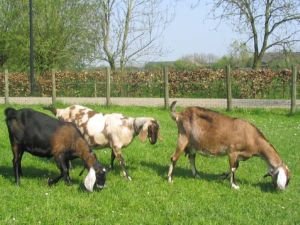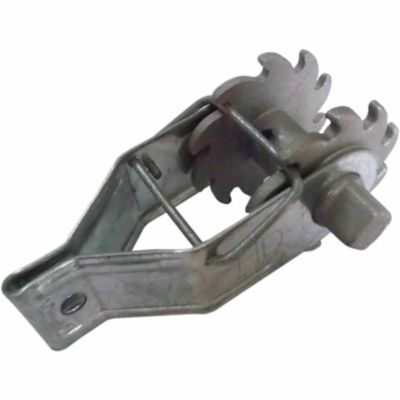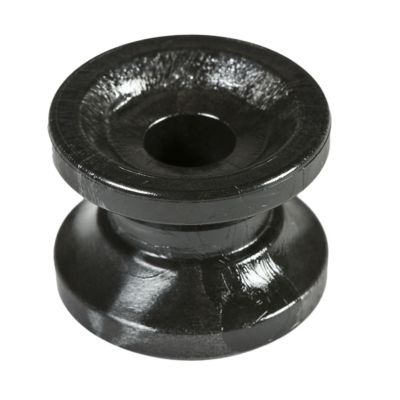How To keep Goats Contained
This Article contains affiliate links.
Goats are constantly escaping and getting into things they shouldn’t. The way I solved this problem of how to keep goats contained is through electric fencing. Starting my homestead, I wanted an animal that I could handle by myself, and I could put more animals into a smaller space. Goats fit what I was looking for and they have their perks. I decided to go with Nubian goats. These goats can be used as a dual purpose of meat and milk which is a perk.
I bought four goats from one of my neighbors and I was able to get them in breeding pairs. I am new to goats but after reading up on them and watching videos and talking to people I thought they were a good fit. These goats are still young and will see if they have baby’s next spring. If they do, I will be able to milk them and then if they have males, I can raise them to butcher. The issue I was going to have is how do I keep them contained that was economical and quick to set up.
Nubian Facts
“The Nubian goat’s coat is short and fine with a glossy appearance. They can be either solid in color or multicolored, usually black, red, or tan. A mature female stands at least 30 inches at the withers (top of the shoulder blades) and weighs 135 pounds or more. Males stand at least 35 inches at the withers and weigh at least 175 pounds. These goats have a distinctly raised, rounded nose in profile.” (https://zooatlanta.org/animal/nubian-goat/)
“These goats live about 10 years, with sexual maturity reached by 3 to 12 months of age. Breeding season is in the fall, and the cycle of a doe lasts 17 to 23 days. Estrus lasts 12 to 48 hours. Gestation lasts 148 to 156 days and results in twins or even triplets.” (https://zooatlanta.org/animal/nubian-goat/)
“Due to their Middle-Eastern heritage, these goats can live in very hot climates and have a longer breeding season than other dairy goats. They are considered a dairy, or dual-purpose, breed. Nubians are known for a high butterfat yield in their milk, on average, 5 percent or more butterfat content. This amount is surpassed only by that of the Nigerian Dwarf, Pygmy goat and Boer goat breeds, all of which are less likely to be used for large scale milk production such as in a dairy or cheese making. Because of the higher fat content, the Nubian milk has more flavor than lower fat milks. Milk production is lower than other dairy breeds on average.” (https://goats.extension.org/goat-breeds-nubian/)


How I keep the Goats Contained
When I first picked up the goats, I was able to buy some horse fencing and put it up around one of my horse stalls. This worked well for a while, but I was going to need a bigger area for them to graze and roam around. After pricing out fencing and t-posts I knew I didn’t want to go that route, so I kept digging and watched some videos of other goat owners, and I decided to do an electric fence to keep the goats contained. I have a local Tractor Supply, so I searched their website for electric fencing and found what I needed. I was able to get the electric polywire, fiberglass posts with clips, tensioners, insulators, and I already had the charger.
Before I started this project I had set metal corner posts and two gate posts so that I could do and fencing. To set the fence up I used bailing wire to tie the insulators to my corner posts and one side of my gate post. On the other gate post I put four tensioners one for each wire run I did. After getting the insulators and tensioners on I tied an end of poly wire to the bottom insulator on the gate post and ran the wire through all the corner post insulators and then to the tensioner where I pulled the wire as tight as I could then tied it to the tensioner and tightened the tensioner until it was tight.
Then I repeated this process for the remaining three runs. After they were all tight, I installed the fiberglass posts every ten feet or so and then put the wire in the clips. For the fence to work I had to put jumper wire and tie all the wires together. Then I hooked up the charger and used a tester to check and make sure it was hot. Everything was working and ready for the goats.
Containment Testing
Introducing the goats to the new area was interesting. The goats had to test the fence and check it out but when they would get shocked, they decided to run through the fence instead of away from it. I had to chase them down and put them back in the paddock. They did this three times then decided it wasn’t worth it and decided to stay in. Every now and then they would get to close and get a shock but wouldn’t run through it. So far the electric fence has been containing them.

The American FarmWorks 1,320 ft. PowerWire Electric Fencing is a lightweight polywire t... [More]

Maintain your fences with the In-Line Clip Wire Strainer. The aluminum alloy ratchet an... [More]

Protect your fencing with the American FarmWorks High Strain Corner and End Insulators.... [More]

Set up your new fence easily with the CountyLine Fiberglass Step-In Post. This fibergla... [More]
Conclusion
To wrap this up I am still early on in my goat raising life and so far, it has been good. The goats have been contained and haven’t had an issue with them getting out once they learn what the fence does and the boundary. This kind of fencing is economical and is easy to set up and manage. Click on the pictures and check out what I used from Tractor Supply